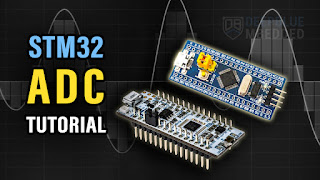How do you set up ADC (Analog-to-Digital Converter) in STM32?
Setting up the ADC (Analog-to-Digital Converter) in an STM32 microcontroller involves configuring the ADC peripheral to read analog signals from one or more input channels and convert them into digital values. STM32 microcontrollers have highly flexible ADC peripherals, and the setup process can vary slightly depending on the specific STM32 series (e.g., STM32F1, STM32F4, STM32H7). Below is a general guide to setting up the ADC in STM32 using STM32CubeMX and HAL (Hardware Abstraction Layer) libraries.
1. Hardware Setup
Connect the analog signal source (e.g., a sensor or potentiometer) to the ADC input pin on the STM32.
Ensure the analog signal voltage is within the ADC's input range (typically 0V to 3.3V for most STM32 devices).
2. Software Setup Using STM32CubeMX
STM32CubeMX is a graphical tool provided by STMicroelectronics to configure STM32 peripherals and generate initialization code.
Steps:
Open STM32CubeMX:
Create a new project and select your STM32 microcontroller.
Enable ADC:
Go to the Analog section and enable the ADC peripheral.
Select the ADC input channel(s) you want to use (e.g.,
IN1,IN2, etc.).
Configure ADC Settings:
Resolution: Set the ADC resolution (e.g., 12-bit, 10-bit, 8-bit, or 6-bit).
Scan Mode: Enable if you want to scan multiple channels.
Continuous Conversion Mode: Enable for continuous conversion or disable for single conversion.
DMA (Direct Memory Access): Enable if you want to use DMA for transferring ADC results to memory.
Sampling Time: Set the sampling time for each channel (longer sampling times improve accuracy for high-impedance sources).
Generate Code:
Configure the clock settings and generate the initialization code.
3. ADC Initialization Code
STM32CubeMX generates initialization code for the ADC in the main.c file. The generated code typically includes:
ADC peripheral configuration.
GPIO configuration for the ADC input pins.
Example of generated ADC initialization code:
static void MX_ADC1_Init(void) { ADC_ChannelConfTypeDef sConfig = {0}; hadc1.Instance = ADC1; hadc1.Init.ClockPrescaler = ADC_CLOCK_SYNC_PCLK_DIV2; hadc1.Init.Resolution = ADC_RESOLUTION_12B; hadc1.Init.ScanConvMode = DISABLE; hadc1.Init.ContinuousConvMode = DISABLE; hadc1.Init.DiscontinuousConvMode = DISABLE; hadc1.Init.ExternalTrigConv = ADC_SOFTWARE_START; hadc1.Init.DataAlign = ADC_DATAALIGN_RIGHT; hadc1.Init.NbrOfConversion = 1; if (HAL_ADC_Init(&hadc1) != HAL_OK) { Error_Handler(); } sConfig.Channel = ADC_CHANNEL_1; sConfig.Rank = 1; sConfig.SamplingTime = ADC_SAMPLETIME_3CYCLES; if (HAL_ADC_ConfigChannel(&hadc1, &sConfig) != HAL_OK) { Error_Handler(); } }
4. Reading ADC Values
To read an analog value from the ADC, use the HAL library functions. Here’s an example of reading a single ADC channel:
uint32_t Read_ADC_Value(ADC_HandleTypeDef* hadc) { uint32_t adc_value = 0; // Start ADC conversion HAL_ADC_Start(hadc); // Wait for conversion to complete if (HAL_ADC_PollForConversion(hadc, HAL_MAX_DELAY) == HAL_OK) { // Read the converted value adc_value = HAL_ADC_GetValue(hadc); } // Stop ADC conversion HAL_ADC_Stop(hadc); return adc_value; }
Example usage in main():
int main(void) { HAL_Init(); SystemClock_Config(); MX_ADC1_Init(); while (1) { uint32_t adc_value = Read_ADC_Value(&hadc1); // Convert ADC value to voltage (if needed) float voltage = (adc_value * 3.3) / 4095; // For 12-bit ADC and 3.3V reference HAL_Delay(100); // Delay between readings } }
5. Advanced Features
Multi-Channel ADC:
To read multiple ADC channels, enable Scan Mode and configure each channel in the ADC settings.DMA:
Use DMA to automatically transfer ADC results to memory without CPU intervention.Interrupts:
Enable ADC interrupts to trigger a callback function when conversion is complete.Oversampling:
Use oversampling to improve ADC resolution and reduce noise.
6. Troubleshooting
Noisy Readings:
Ensure proper grounding, use decoupling capacitors, and increase sampling time.Incorrect Values:
Verify the ADC reference voltage and ensure the input signal is within the valid range.DMA Issues:
Check DMA configuration and ensure the buffer size matches the number of conversions.
Summary of Steps:
Use STM32CubeMX to configure the ADC peripheral.
Generate initialization code.
Use HAL functions to start, read, and stop ADC conversions.
Optionally, use DMA or interrupts for advanced functionality.
By following these steps, you can set up and use the ADC in STM32 microcontrollers effectively for various analog signal acquisition tasks.



评论
发表评论